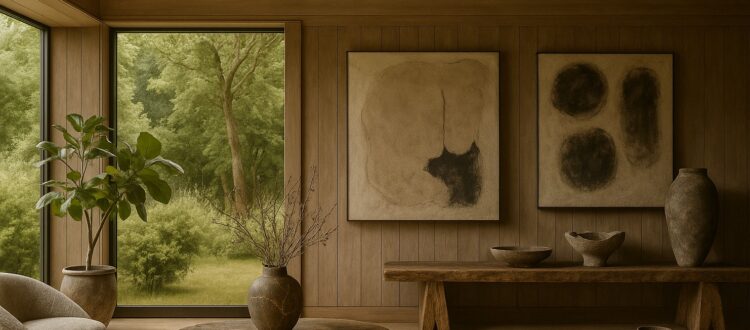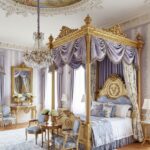Beauty in Imperfection: A Guide To Wabi Sabi Interior Design
“Wabi-Sabi”, a Japanese aesthetic, whispers stories of beauty in imperfection. In a world that celebrates clean lies, perfection and symmetry, wabi sabi is a principle that celebrates imperfection, simplicity, and the beauty of things that are real, aged, and fleeting. The Wabi Sabi philosophy is not confined to interior decor alone, but is a way of thinking that can be applied to all the facets of your life. Rooted in the principles of Zen Buddhism, this concept invites contemplation of the natural, the incomplete, and the ephemeral.
When applied to modern interiors, Wabi Sabi in home decor is a design approach that emphasises a home where imperfection is not a flaw but a feature, and where serenity stems from authenticity rather than excess.
In this article, we will explore the principles of Wabi-Sabi and how incorporating Wabi-Sabi into interior design can elevate your decor with sophistication and harmony.
What Is Wabi Sabi?
At its core, Wabi Sabi is a way of life, a way of thinking that helps find beauty in imperfection and impermanence. The meaning of the term ‘Wabi Sabi’ can be explained as follows:
Wabi: refers to living with humility and simplicity while being at one with nature.
Sabi: refers to the passage of time and the ability to accept the lifecycle of anything as it is—flaws and all.
https://www.youtube.com/watch?v=0JsWIihKpu4
Video Credit: Dans Le Gris
Origins Of Wabi Sabi
The origin of the Wabi Sabi philosophy can be traced back to the tea ceremonies of 16th-century Japan. It was seen as a counter-movement to the lavish, ornate Chinese aesthetic that was popular at the time. Rather than using flawless porcelain, tea masters chose handmade, uneven pottery, appreciating its irregular shape and texture.
Also Read: Japanese Art Of Kintsugi
Wabi Sabi in Interior Design
When applied to décor, Wabi Sabi interior design is about creating a home that feels calm, natural, and imperfectly beautiful. Instead of aiming for perfection, Wabi Sabi interiors focuses on:
- Natural authenticity over artificial polish
- A sense of calm through minimalism and balance
- A lived-in feel where signs of use are valued, not hidden
Key Elements of Wabi Sabi Interiors
Wabi Sabi interiors incorporate neutral tones, natural elements and aged decor pieces that have personal value.
- Natural Elements
Wabi Sabi interior design embraces natural elements for materials. Think raw wood, stone, clay, linen, jute, rattan, bamboo, and paper.
- Neutral Colour Palette
Wabi Sabi design element incorporates earthy tones and muted colours. Think soft greys, warm whites, muted greens, deep blues, terracotta, and various shades of brown.
- Asymmetry and Irregularity
Bid farewell to perfect symmetry and straight lines. Wabi-Sabi celebrates the beauty of natural forms – a slightly uneven ceramic bowl, a hand-hewn wooden bench, a perfectly imperfect piece of driftwood, all these help celebrate imperfection as a character.
- Handcrafted & Organic Forms
Wabi Sabi home decor calls for handcrafted objects. Think hand-thrown pottery, woven textiles, and carved wooden objects.
- Simplicity & Minimalism
Wabi-Sabi spaces are free from clutter, focusing on a minimalistic decor.
- Negative Space
Wabi Sabi interior design incorporates the concept of ‘Negative Space’.
Negative space refers to the intentionally empty areas around and between furnishings and decor, also known as “breathing room”, that minimises clutter and creates visual harmony and balance.
- Ageing & Patina
Unlike modern designs that aim to preserve pristine conditions, Wabi-Sabi embraces the natural ageing of materials. Patina, rust, cracks, and weathering are not flaws—they’re beauty marks in Wabi Sabi interiors.
Crafting Your Wabi Sabi Sanctuary
Looking to incorporate Wabi Sabi in your design style? Look no further! We have got you covered with our guide on creating a tranquil Wabi Sabi interior with creative tips.
First, let us see what all the decor elements are that you can incorporate in your Wabi Sabi interior.
What to Include: Wabi Sabi Furniture, Art, and Decor
- Wabi Sabi Furniture

Solid wood furniture perfectly embodies the Wabi-Sabi aesthetic. Look for pieces made from raw, untreated wood (reclaimed wood is excellent), distressed finishes, or simple, understated design.
Tips & Suggestions:
- Low, grounded seating with linen or cotton slipcovers that crease and relax over time.
- Open shelving in raw oak, reclaimed timber benches, simple stools, and leggy side tables with a matte oil finish.
- Avoid heavy lacquer, mirrored finishes, or overly sculpted forms; prioritize comfort, tactility, and silhouette.
- Wabi Sabi Paintings

Art in a Wabi-Sabi home tends to be subtle and evocative.
What to Look for:
- Minimal Brush Strokes: look for work with minimal brush strokes that convey emotion rather than intricate detail.
- Unconventional Compositions: Off-centered designs or arrangements carry emotional weight.
- Negative Spaces: Hang fewer pieces; allow negative space to frame each work.
- Wabi Sabi Decorative Arts

Wabi-sabi decorative arts include items highlighting imperfection, asymmetry, simplicity, and natural materials.
- Pottery & Ceramics: Hand-thrown, unglazed, or roughly glazed pottery with natural variations and imperfections
- Kintsugi Pieces: If you have broken ceramics, consider repairing them with the kintsugi method to highlight their history.
- Textiles: Linen curtains, throws, and cushions with a relaxed, slightly crinkled look.
- Antiques & Vintage Finds: Objects that show their age, wear, and history are perfectly aligned with Sabi.
How to Create Wabi-Sabi Interiors: Tips for a Harmonious Home

Creating a wabi-sabi space in your home is all about embracing imperfection and creating a warm and cosy environment.
- Declutter
Before incorporating Wabi Sabi in your interior, it is important to declutter. Start by removing anything that doesn’t serve a purpose or bring you joy.
- Choose Natural Materials
Wabi Sabi design elements cherish natural materials like wood, linen, etc. Replace plastic and synthetic items with wood, linen, stone, and wool.
- Choose a Muted Palette
Paint walls in soft, earthy tones. Layer textiles in complementary natural shades.
- Celebrate Imperfection
Display items with cracks, chips, or irregular shapes instead of hiding them.
- Decorate with Treasured Items
Surround yourself with things you truly treasure. It could be a family heirloom, a precious gift or handmade pottery.
- Use Soft Lighting
Wabi Sabi intends to create a tranquil and harmonious atmosphere. Use warm, diffused lighting to create a cosy, calming atmosphere.
- Seek Out Handmade & Unique Pieces
Visit artisan markets, flea markets, or independent craft stores. Look for items with character and a story.
- Connect with Nature
Wabi Sabi is all about connecting with nature. Bring nature indoors with wide windows, indoor plants and natural lighting.
- Practice Mindful Placement
Arrange objects thoughtfully, allowing each piece to have its own space and breathing room. Asymmetrical arrangements often feel more natural
- Focus on Texture
Create visual interest through a variety of textures – rough wood, smooth stone, soft linen, coarse pottery.
Most importantly, remember a Wabi Sabi home is never finished. It evolves with you, your life, and the passage of time.
Embrace Imperfection
The heart of Wabi Sabi interiors is learning to see imperfection as beauty. That worn-out rug, the table with scratches, the uneven pottery—they all tell stories. Your home doesn’t need to look like a showroom; it should feel alive, comfortable, and true to you.
By embracing imperfection, you not only create a unique home but also a healthier mindset: less pressure, more acceptance, more peace.






